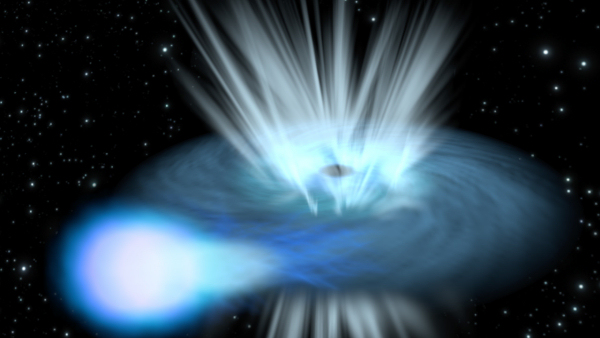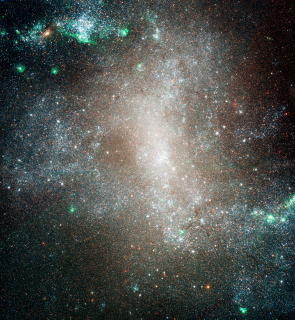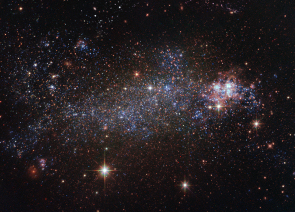Powerful winds spotted from mysterious X-ray binaries
28 April 2016
ESA's XMM-Newton has discovered gas streaming away at a quarter of the speed of light from very bright X-ray binaries in two nearby galaxies.
 |
| High-speed winds from X-ray binary. Credit: ESA–C. Carreau |
At X-ray wavelengths, the celestial sky is dominated by two types of astronomical objects: supermassive black holes, sitting at the centres of large galaxies and ferociously devouring the material around them, and binary systems, consisting of a stellar remnant – a white dwarf, neutron star or black hole – feeding on gas from a companion star.
In both cases, the gas forms a swirling disc around the compact and very dense central object: friction in the disc causes the gas to heat up and emit light at many wavelengths, with a peak in X-rays.
Not all of the gas is swallowed by the central object though, and some of it might even be pushed away by powerful winds and jets.
But an intermediate class of objects was discovered in the 1980s and is still not well understood. Ten to a hundred times brighter than ordinary X-ray binaries, these sources are nevertheless too faint to be linked to accreting supermassive black holes, and in any case, are usually found far from the centre of their host galaxy.
"We think these 'ultra-luminous X-ray sources' are somewhat special binary systems, sucking up gas at a much higher rate than an ordinary X-ray binary," explains Ciro Pinto from the Institute of Astronomy in Cambridge, UK.
"Some host highly magnetised neutron stars, while others might conceal the long-sought-after intermediate-mass black holes, which have masses around 1000 times the mass of the Sun. But in the majority of cases, the reason for their extreme behaviour is still unclear."
Ciro is the lead author of a new study, based on observations from ESA's XMM-Newton, revealing for the first time strong winds gusting at very high speed from two of these exotic objects. The discovery, published in this week's issue of the journal Nature, confirms that these sources conceal a compact object accreting matter at extraordinarily high rates.
 |
| Host galaxy NGC 1313. Credit: NASA, ESA & A. Pellerin (STScI) |
Ciro and his colleagues delved into the XMM-Newton archives and collected several days' worth of observations of three ultra-luminous X-ray sources, all hosted in nearby galaxies located less than 22 million light-years from our Milky Way.
The data were obtained over several years with the Reflection Grating Spectrometer, a highly sensitive instrument that allowed them to spot very subtle features in the spectrum of the X-rays from the sources.
In all three sources, the scientists were able to identify X-ray emission from gas in the outer portions of the disc surrounding the central compact object, slowly flowing towards it.
But two of the three sources – known as NGC 1313 X-1 and NGC 5408 X-1 – also show clear signs of X-rays being absorbed by gas that is streaming away from the central source at an extremely rapid 70 000 km/s – almost a quarter of the speed of light.
"This is the first time we've seen winds streaming away from ultra-luminous X-ray sources," says Ciro.
 |
| Host galaxy NGC 5408. Credit: ESA/Hubble & NASA. Acknowledgement: J. Schmidt (Geckzilla) |
"And there's more, since the very high speed of these outflows is telling us something about the nature of the compact objects in these sources, which are frantically devouring matter."
While the hot gas is pulled inwards by the central object's gravity, it also shines brightly, and the pressure exerted by the radiation pushes it outwards. This is a balancing act: the greater the mass, the faster it draws the surrounding gas. But this also causes the gas to heat up faster, emitting more light and increasing the pressure that blows the gas away.
There is a theoretical limit to how much matter can be accreted by an object of a given mass, called the 'Eddington luminosity'. It was first calculated for stars by astronomer Arthur Eddington, but it can also be applied to compact objects like black holes and neutron stars.
Eddington's calculation refers to an ideal case in which both the matter being accreted onto the central object and the radiation being emitted by it do so equally in all directions.
But the sources studied by Ciro and his collaborators are being fed through an accretion disc that is likely being puffed up by internal pressure of the gas flowing at a fast pace towards the central object.
In such a configuration, the material in the disc can shine 10 times or more above the Eddington limit and, as part of the gas eludes the gravitational grasp from the central object, very high-speed winds can arise like the ones observed by XMM-Newton.
"By observing X-ray sources that are radiating beyond the Eddington limit, it is possible to study their accretion process in great detail, investigating by how much the limit can be exceeded and what exactly triggers the outflow of such powerful winds," says Norbert Schartel, ESA XMM-Newton Project Scientist.
The nature of the compact objects hosted at the core of the sources observed in this study is, however, still uncertain, although the scientists suspect it might be stellar-mass black holes, with masses of several to a few dozen times that of the Sun.
To investigate further, the team is still scrutinising the data archive of XMM-Newton, searching for more sources of this type, and are also planning future observations, in X-rays as well as at optical and radio wavelengths.
"With a broader sample of sources and multi-wavelength observations, we hope to finally uncover the physical nature of these powerful, peculiar objects," concludes Ciro.
Notes for Editors
"Resolved atomic lines reveal outflows in two ultraluminous X-ray sources," by C. Pinto et al., is published in the journal Nature, doi: 10.1038/nature17417.
For further information, please contact:
Ciro Pinto
Institute of Astronomy, University of Cambridge
United Kingdom
Tel: +44 1223 339281
Email: cpinto![]() ast.cam.ac.uk
ast.cam.ac.uk
Norbert Schartel
ESA XMM-Newton Project Scientist
Email: Norbert.Schartel![]() esa.int
esa.int
Markus Bauer
ESA Science Communication Officer
Tel: +31 71 565 6799
Mob: +31 61 594 3 954
Email: markus.bauer![]() esa.int
esa.int



